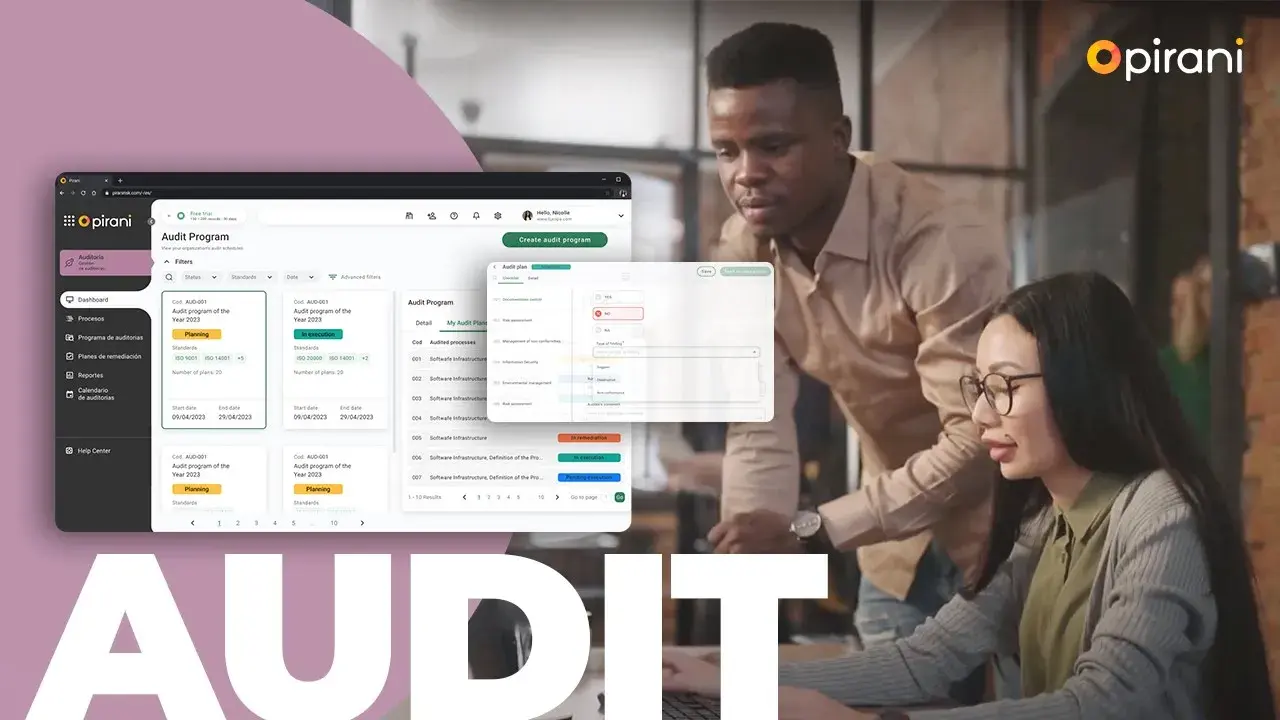Crafting Risk Management Plan: Step-by-Step Guide
Creating a robust risk management plan can safeguard your organization’s most valuable assets and its hard-earned reputation. It acts as a blueprint for project managers seeking resilience, preparedness, and effective decision-making in the face of operational risks you might encounter.

Operational risks, from internal processes of project teams and technology vulnerabilities to external events and market fluctuations, pose real and immediate threats.
But here’s the catch: Risk doesn’t differentiate when it comes to a business's size and/or nature. Whether you’re a global financial institution or a local boutique, the need for a comprehensive risk management template remains the same.
For example, COVID-19 disrupted nearly 80% of business operations for businesses worldwide. Such risk events can have a far-reaching impact on your business’s success.
In this article, we’ll go over the essential steps to create a comprehensive risk management plan. We will delve into the key components and strategies that can empower businesses of all sizes to navigate potential risks and conduct a solid risk analysis with team members.
Keep reading to join us on this journey to fortify your organization and safeguard its assets against the unpredictable through effective risk mitigation.
What is a Risk Management Plan?
A Risk Management Plan (RMP) is a comprehensive framework and part of the risk management process. It’s designed to identify, assess, and mitigate the various risks that an organization faces, with the primary objective of safeguarding its assets, reputation, and operations.
While similar in concept to other strategic plans, such as business plans or financial plans, the project risk management plan is distinct in its focus, the way it structures ‘milestones’, and other unique elements.
At its core, a Risk Management Plan serves as a proactive and forward-looking strategy that enables an organization to:
- Identify and understand potential internal and external risks that could disrupt its operations or cause harm.
- Evaluate these risks' likelihood and potential impact, allowing for the prioritization of risk mitigation efforts.
- Develop and implement strategies to reduce, transfer, or accept these risks, ensuring the organization’s ability to adapt to unforeseen circumstances.
- Continuously monitor the risk landscape and adjust strategies in response to emerging threats or changes in the business environment.
- Provide a framework for effective communication of risk findings and strategies to stakeholders, both internally and externally.
The Risk Management Plan has a distinct focus on risk identification and mitigation. It encompasses specific elements, such as risk assessment methodologies, risk mitigation strategies, and contingency plans, which are not typically found in other strategic documents.
Key Components of a Risk Management Plan
A comprehensive Risk Management Plan (RMP) comprises several key components that form the foundation for safeguarding an organization from operational risks. These include:
- Risk Identification: Pinpointing potential threats and vulnerabilities is the first step in creating an effective RMP. This involves a thorough examination of both internal and external factors while recognizing the nitty-gritty of each scenario.
- Risk Assessment: Evaluating the likelihood and impact of identified risks allows for a deeper understanding of their significance. Organizations can prioritize their mitigation efforts by assigning a risk rating to each identified threat.
- Risk Response: Crafting strategies to avoid, transfer, mitigate, or accept risks is a pivotal component of RMP. These strategies can include avoiding, transferring, mitigating, or accepting risks, depending on their nature and potential consequences. A well-thought-out risk response plan is essential for minimizing the impact of potential disruptions.
Source: 4SquareViews
- Monitoring and Review: Your RMP will always change, being a dynamic document that evolves with your business is environment. Ensuring ongoing assessment of risks and the effectiveness of response strategies keeps your RMP relevant.
Steps to Create a Risk Management Plan
Creating a comprehensive Risk Management Plan (RMP) is a meticulous process that requires a structured approach. To keep your organization prepared against operational risks, follow this essential checklist:
- Establish Your Context
- In this planning phase, understand your organization’s objectives, industry, and the unique context in which it operates.
- Identify key stakeholders, their interests, and any regulatory or compliance requirements relevant to your business.
- Risk Identification
- Use tools like SWOT analysis, brainstorming sessions, and historical data to identify potential risks and create a risk register.
- Involve employees, stakeholders, and subject matter experts in the workflows to gain diverse perspectives and insights.
- Risk Assessment
- Rank risks based on their potential impact and likelihood using tools like a risk assessment matrix.
- Prioritize risks to determine where to allocate resources for your mitigation plan.
- Develop Your Risk Response Strategies
- Outline specific actions for each identified risk. For each risk, detail strategies for avoiding, transferring, mitigating, or accepting it.
- Define clear response protocols that align with your organization's overall goals.
- Assign Roles and Responsibilities
- Designate individuals or teams to manage specific risks such as risk owners and oversee response actions.
- Ensure that project objectives, roles, and responsibilities are well-defined and communicated to all relevant parties. Make sure dependencies are clear.
- Communication and Documentation
- Ensure all internal and external stakeholders are aware of the plan and can access it easily.
- Create a structured and accessible document that includes risk profiles, response plans, and contact information.
- Regularly Review and Update Your Plan
- Schedule periodic risk monitoring evaluations to assess the effectiveness of your RMP.
- Adjust the plan based on new risks, organizational changes, or lessons learned from previous incidents.
By following this systematic approach, organizations can proactively manage operational risks and navigate uncertainties confidently, while Pirani Risk’s innovative solutions stand ready to support and enhance every phase of this process.
Challenges in Creating a Risk Management Plan
Understanding and addressing these potential pitfalls is essential to ensure your risk management plan template’s effectiveness and adaptability:
- Ignoring Emerging Risks: One common pitfall is focusing solely on known types of risks while overlooking emerging threats and other possible risks. To avoid this, maintain a vigilant stance, continually monitor the risk landscape, and incorporate a mechanism for identifying and assessing new risks as they arise.
- Underestimating Human Factors: Human error, misconduct, and inadequate training can be significant operational risks. Make sure to involve your employees in the risk management process, provide ongoing training, and establish clear procedures for risk mitigation.
- Static and Rigid Plans: A static risk management plan will do you no good. Ensure that your RMP is adaptable, with regular reviews and updates scheduled to reflect changes in the business environment.
- Lack of Project Stakeholder Involvement: Failing to engage stakeholders in the risk management process can hinder the effectiveness of the RMP. Involve key stakeholders, including employees, management, and external parties, to gain a comprehensive understanding of risks and potential solutions.
- Insufficient Resources: Allocating inadequate resources to risk management can be an obstacle to your risk project’s success. Make sure your RMP has the necessary resources, whether it’s in terms of personnel in your risk management team, technology for risk management activities, or financial investments as part of mitigation actions.
Simplify the Creation and Monitoring of Risk Management Plans with Pirani Risk
There’s no doubt that a well-structured RMP is an essential foundation for safeguarding your organization from the unpredictability of operational risks. It’s the key to resilience, preparedness, and effective decision-making when facing uncertainty, especially when weighing up the impact of the risk on specific project progress and project schedules.
You can simplify the process of crafting and monitoring your RMP with Pirani. We also offer audit support.
Our cutting-edge software is designed to streamline your risk management journey by automating risk identification and assessment to help you plan for uncertain events. With our advanced algorithms and real-time data analysis, you can stay ahead of emerging threats while being updated on the level of risk your business is always facing.
Get started by viewing a demo of Pirani in action, granting you a hands-on experience with our software and showing you how to use it to start managing risks.
The journey to resilience begins with a single step—let us be your partner in that journey.
You May Also Like
These Related Stories

5 steps for financial risk analysis

Steps to develop an AML risk management matrix

Step-by-Step Guide: How to Create a Risk Matrix

How to make an internal audit plan?

Steps to implement a risk management system

No Comments Yet
Let us know what you think